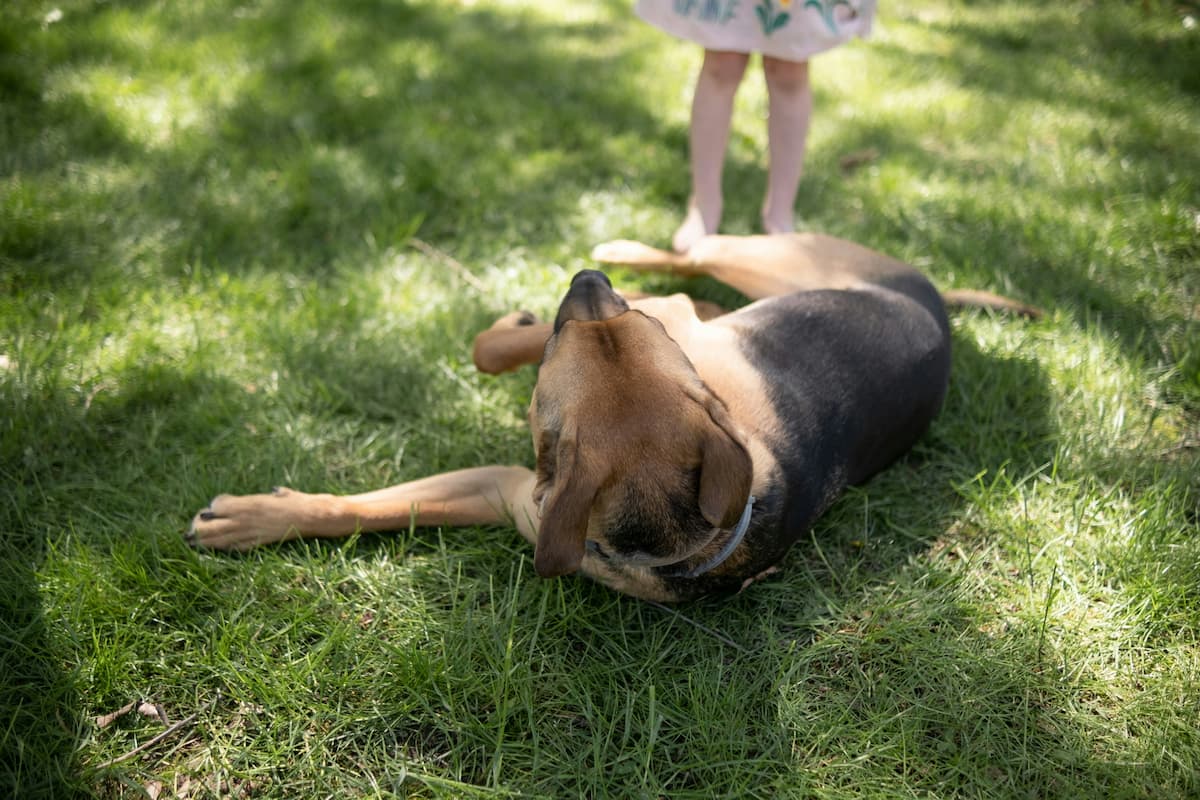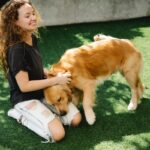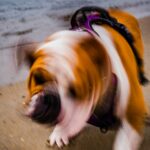Have you ever noticed that right before your four-legged pal curls up for a nap, they perform a little dance routine?
A little twist here, a twirl there, and finally, they settle down in their favorite spot.
It seems like an amusing ritual, but have you ever wondered why dogs do this peculiar pre-slumber spin?
Read on to find out.
Why Do Dogs Twirl Before Lying Down?
Dogs truly are fascinating creatures.
Just when you think you’ve figured them out, they surprise you with a peculiar behavior like twirling before lying down.
If you’ve ever wondered why on earth your furry friend does this adorable little dance routine, you’re not alone.
Here are some reasons behind this sweet and quirky behavior.
Orientation and Comfort:
1. It’s all about finding the perfect spot!
Dogs have an innate instinct to create a cozy and safe sleeping environment.
By twirling, they are essentially marking their territory and ensuring they have a clear and comfortable area to rest.
It’s like they’re testing the grass or bedding, ensuring everything is just right before they settle down.
2. This behavior can be traced back to their wild ancestors.
Wolves, from whom domestic dogs descended, would tread in circles before lying down to flatten the grass or foliage and create a makeshift nest.
It’s fascinating to see how deeply ingrained these primal instincts still are in our beloved pets.
3. Recent studies have investigated the possibility that dogs align their bodies along the Earth’s magnetic field before settling down.
Twirling could be a way for dogs to find the optimal position to align themselves with the Earth’s magnetic forces and increase their sense of security while sleeping.
Temperature Regulation:
1. Believe it or not, twirling can also help regulate a dog’s body temperature.
By turning around in circles, they can create a small depression on the ground, allowing cooler air to circulate beneath them.
This helps prevent overheating, especially during hot summer months or if they have a thick coat.
2. In addition, by twirling, dogs can expose different parts of their body to different temperatures.
They might position their nose towards a cool breeze or their back towards a warm patch of sunlight.
Dogs are intuitive creatures who know how to adapt and make themselves as comfortable as possible.
Instinctual Behavior and Exercise:
1. Twirling before lying down is often seen as an instinctual behavior that stems from their wolf ancestry.
In the wild, wolves would circle their sleeping areas to trample down any obstacles, clear debris, and keep an eye out for potential predators.
While our pampered pets may not have to worry about those same dangers, this behavior is deeply rooted in their DNA and is a natural part of their routine.
2. Additionally, twirling can serve as a form of exercise for our four-legged friends.
Dogs are active animals that require mental and physical stimulation.
By engaging in a little pre-sleep twirl, they can release some excess energy and ensure a more peaceful slumber.
3. Lastly, twirling can also be related to a dog’s marking behavior and territorial instincts.
As dogs rotate in circles, they are depositing their scent on the ground.
This is a way for them to establish and claim their territory.
By marking the area where they intend to sleep, they are communicating to other dogs that this spot is already taken.
This territorial marking behavior is deeply ingrained in their instincts, dating back to their wild ancestors who needed to protect their sleeping spots from potential intruders.
Training Techniques to Modify Twirling Behavior
So, how can we modify this twirling behavior?
Well, the key lies in consistent training techniques.
First and foremost, it’s important to establish clear and concise commands.
Start by using a command like “Bed” or “Lie Down” and reward your pup with treats and praise when they follow the command without twirling.
Consistency is key, so make sure to reinforce this behavior every time.
Over time, your furry friend will begin to associate the command with lying down without the need for twirling.
In addition to training, providing a designated resting area for your dog can also help modify their twirling behavior.
A cozy dog bed or mat can serve as their special spot to unwind and relax.
By consistently directing your dog to their designated resting place, you are reinforcing the idea that twirling is unnecessary.
Remember to make their resting area as comfortable and inviting as possible, perhaps by adding their favorite toys or a soft blanket.
So there you have it, folks!
The mystery behind why our beloved canines twirl before lying down is not so mysterious after all.
With the right training techniques and consistency, we can modify this behavior and ensure our furry friends have a peaceful snooze without the dizzying twirls.
Happy training!
FAQ
Q: Why on earth do dogs feel the need to twirl around before settling down?
A: Well, believe it or not, dogs have some ancient reasons behind this peculiar behavior.
Back in the day, before dogs became our beloved pets, their ancestors roamed wild and untamed.
It’s believed that this twirling behavior has roots in the instinctive behaviors of their wolf ancestors.
Q: Really?
How does it connect to their wild ancestors?
A: Picture this: in the wild, dogs had to find the perfect spot to lie down, away from any potential dangers lurking in the surroundings.
By spinning around in circles, they would flatten the tall grass or leaves, creating a suitable nest.
This habit allowed them to clear any stones, twigs, or creepy crawlies that could ruin their comfy nap.
Q: But isn’t their bed already free of such hazards?
A: You’re absolutely right!
Modern-day dogs are lucky enough to enjoy comfy beds and cozy corners without the same risks their wild counterparts faced.
However, their innate instinct to clear their sleeping area has stuck with them through generations.
So, even if fluffy pillows are already in place, they still go through the twirling routine out of habit or perhaps to fulfill that primal drive.
Q: Is there any other reason behind this behavior?
A: Some experts believe that dogs twirl as a way to mark their territory.
Strange, right?
By spinning around, they leave their scent behind through glands located in their paws.
It’s like them saying, ”Hey, I claim this spot as mine!” So, aside from being adorable, their twirling dance may actually serve a functional purpose.
Q: Are all dogs prone to this behavior?
A: While it’s true that some dogs can twirl more than others, this behavior isn’t universal.
Certain breeds may exhibit the twirling behavior more prominently than others.
For instance, herding dogs like Border Collies, German Shepherds, or Australian Shepherds are often seen twirling excessively.
It may be related to their instinct to herd and protect their flock.
Q: Can we do anything to discourage or stop this twirling behavior?
A: Well, the reality is, this behavior is deeply ingrained in our canine pals.
Trying to completely eliminate it may be challenging.
However, you can redirect their twirling by teaching them a new command, like ”Go to bed!” or “Settle.”
When they start spinning, you can guide them gently to their bed or designated resting area.
Over time, they may connect the command with lying down and might skip the twirling process.
Q: So, there’s a fascinating piece of history behind it when next time I see my dog twirling?
A: Absolutely!
Now you can appreciate your four-legged companion’s twirling routine in a whole new light.
Remember, it’s a charming remnant of their wild ancestors and an instinctual habit that can’t be easily broken.
So, embrace their twirling ways and perhaps clear a little space for them to perform their pre-nap ritual.
After all, our furry friends never cease to surprise us with their interesting behaviors!
The Farewell Notes
Next time you spot your canine companion twirling around in circles, remember that this seemingly peculiar act is actually deeply ingrained in their DNA.
From their distant wolf ancestors to the beloved pets we know today, dogs have inherited this age-old instinctual response to create a comfortable and safe sleeping spot.
So, as you observe your four-legged friend spin around with excitement, take a moment to appreciate the fascinating world of canine behavior.
They may have evolved drastically from their wild ancestors, but these adorable quirks remind us of their remarkable journey alongside us humans throughout history.
And the next time you see your pooch twirling before settling down, you can sit back, smile, and know that in their own delightful way, your furry companion is embracing their inner wolf, preparing for a well-deserved rest, and creating their own little safe haven in the vast human world.












